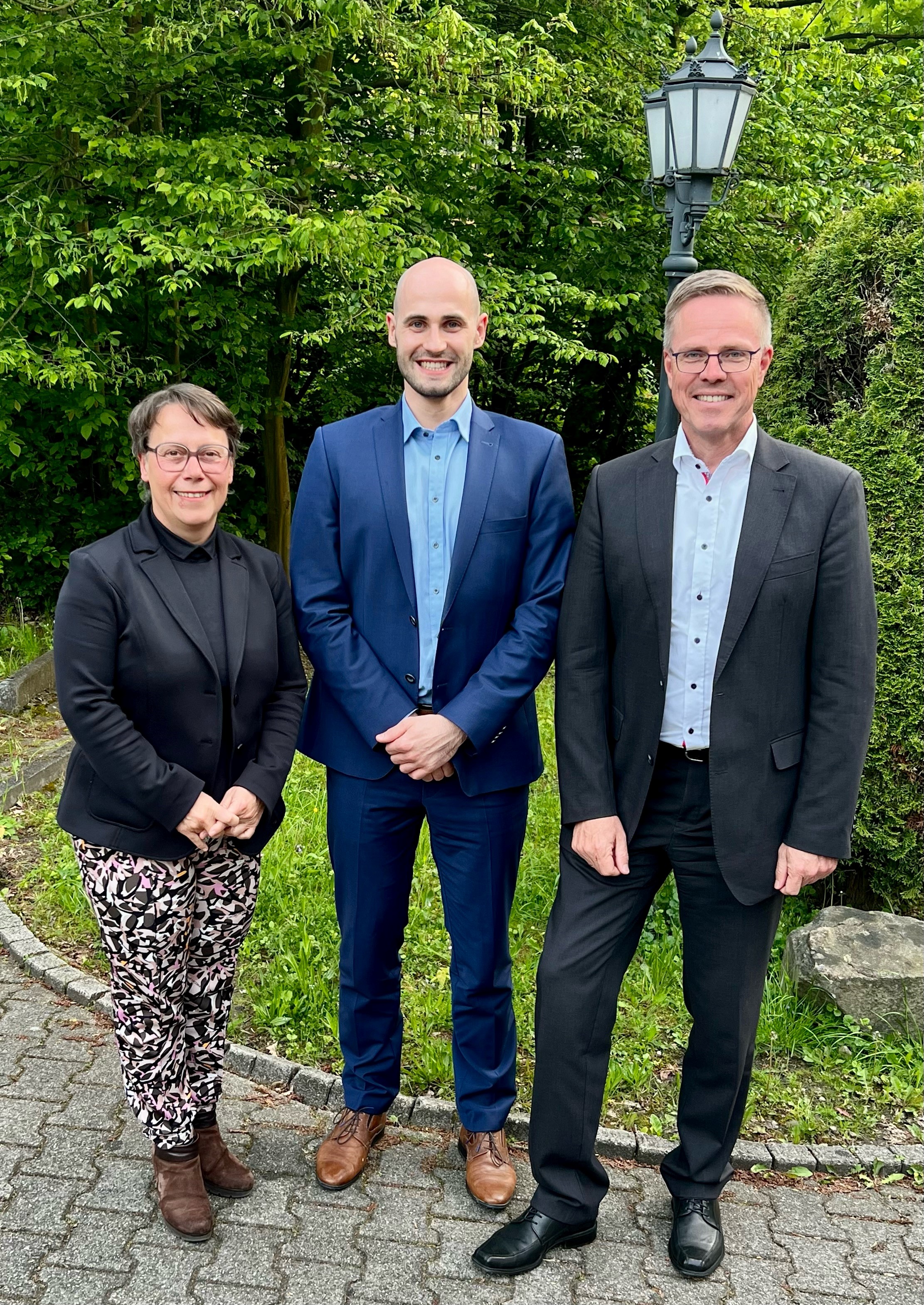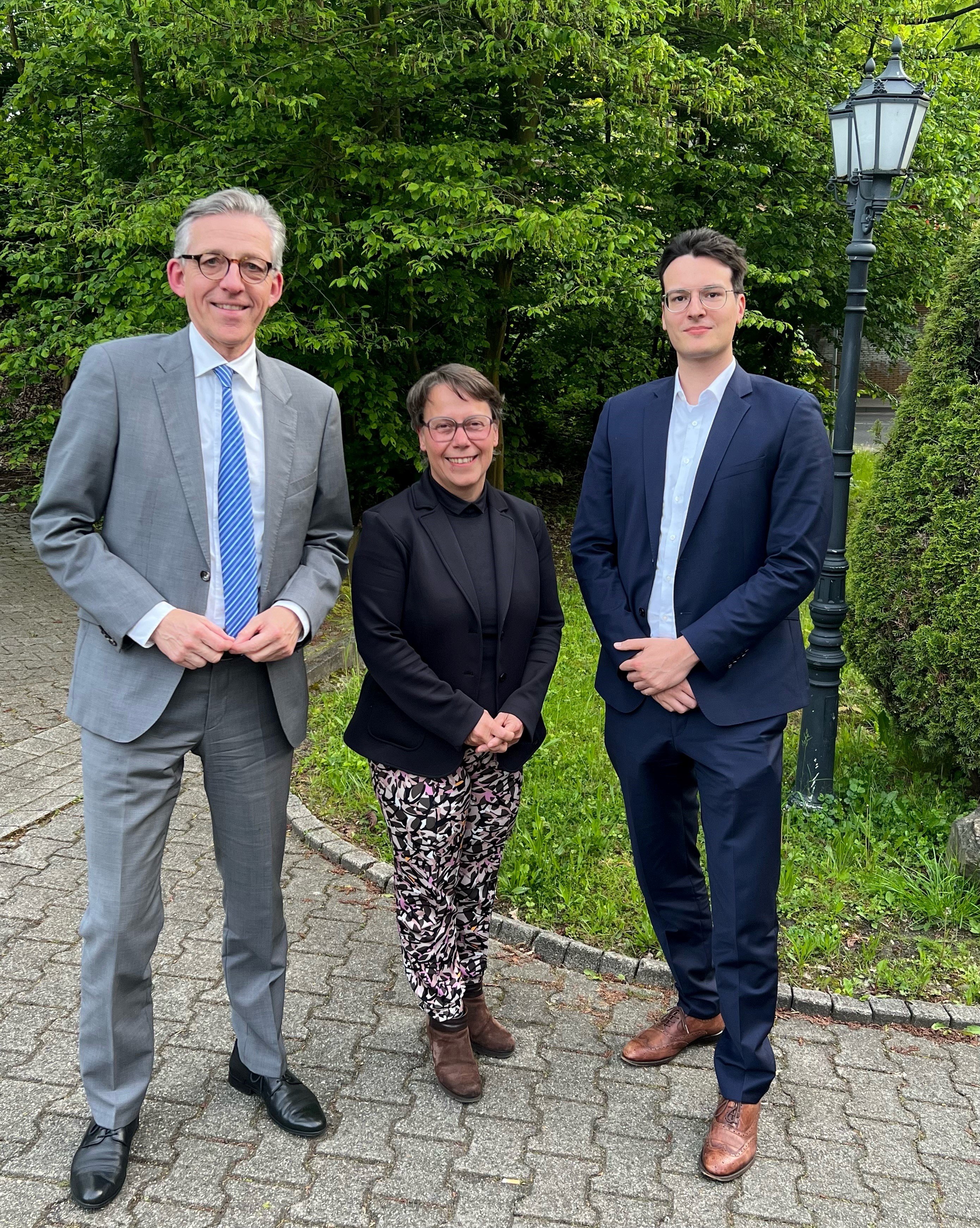Ernst Zander Prize 2023
On 17.5.2023 the Ernst Zander Prize 2023 was awarded. This prize, donated by Prof. Dr. Ernst Zander, is awarded annually for outstanding scientific achievements (primarily dissertations) from all faculties of the Ruhr-Universität, in particular from the faculties of economics, law and engineering. The selection of the prize-worthy works is made -on the suggestion of the Institute for Corporate Management (ifu) of the Ruhr-Universität Bochum- by the board of the Alwin Reemtsma Foundation, which includes the Chancellor of the Ruhr-Universität, who also performed this year's award ceremony.
This year, as in several previous years, the prize was split. Dr. Simon Fahle (Development of a machine learning approach for quality improvement in radial-axial ring rolling by time series classification, supervisor: Prof. Dr.-Ing. Bernd Kuhlenkötter, second referee: Prof. Dr.-Ing. Detlef Gerhard) and Dr. Doron Reichmann (Qualitative Disclosures and Capital Market Consequences - A Textual Analysis Approach, supervisor: Prof. Dr. Stephan Paul, second referee: Prof. Dr. Devrimi Kaya) were awarded the prize.
Dr.-Ing. Fahle worked as a research assistant at the Chair of Production Systems of Prof. Dr.-Ing Bernd Kuhlenkötter from February 2019 to April 2022. From May 2022, he will work as a business analyst at Westnetz GmbH in Dortmund.
Dr. Doron Reichmann joined the Chair of Finance and Credit Economics of Prof. Dr. Stephan Paul as a research associate in May 2019. As of July 2022, he has taken over the management of the FAACT research group of the Bochum Faculty of Economics.

The photo shows from left to right: Dr. Christina Reinhardt, Dr. Simon Fahle and Prof. Dr. Bernd Kuhlenkötter.
©ifu, Seidler
Development of a machine learning approach for quality improvement in Radial-Axial Ring Rolling by Time Series Classification
Numerous technical innovations and decades of research have allowed the process of radial-axial ring rolling to grow into a significant manufacturing process for seamlessly formed ring-shaped components. In times of global warming and the resulting global CO2 reduction campaigns, hot forming must also set itself new goals for CO2 reduction. Recent developments in machine learning, especially the breakthrough of deep neural networks in recent years, offer novel opportunities in various industrial sectors. Linking the latest machine learning models with process data generated within the ring rolling process offer the possibility of optimizing the rolling process. This optimization aims at increased resource and cost efficiency by reducing material additions and avoiding scrap. This is implemented in the dissertation of Dr.-Ing. Simon Fahle by developing a time series classification model for quality prediction and extending it to a time series model for the early prediction of out-of-roundness while rolling is still in progress. The early prediction can thus not only predict shape defects after the process and without surveying periphery, but also detect them already during rolling and implement suitable counter-rolling measures. The development of the time series classification model is based on the procedure model of the Cross Industry Standard Process for Data Mining. Within the application in radial-axial ring rolling, all six steps of the process model are run through. It starts with the problem definition and the selection of a suitable metric. Subsequently, the basis for model building is created by extensive data acquisition followed by data pre-processing. The machine learning models used within the thesis will be validated using test data and finally a prototypical implementation will be installed on the chair's own ring rolling mill. Within the development of the models and especially during the data acquisition of industrial data at a production line at thyssenkrupp rothe erde Germany GmbH the challenge of the acquisition of high quality supervised learning data becomes visible. More than 1200 high quality supervised learning data are recorded within the research work at great effort. To address this grievance of expensive and laborious data acquisition, two potential solutions are developed with the exploration of a semi-supervised learning approach and synthetic data generation through generative networks. First, the semi-supervised approach additionally uses unclassified log files of ring rolling mills for improving the prediction accuracy. The advantage within this solution is that it is much easier to obtain the unclassified log files without the matching labels in the form of surveys. On the other hand, generative networks are trained on the basis of the existing database, so that these have the ability to generate new and thus synthetically generated log files themselves, with or without pronounced shape errors. These synthetic log files can then also be used to improve the accuracy of existing models. In summary, the results of the dissertation emphasize that the application of machine learning methods creates several opportunities to make the production process more efficient. On the one hand, expensive and high-maintenance additional peripheral equipment such as an automatic measuring system can be replaced. On the other hand, the production process can be analyzed and thus intervened in the running process in time, so that scrap and rework can be reduced. This reduction ensures a reduction in C02 emissions, especially in a hot forming process such as radial-axial ring rolling, since less raw material has to be produced and heated in the blast furnaces. In addition, innovative transfer approaches were developed to improve the prediction quality of the developed models in the area of time series classification by using state-of-the-art models from the area of semi-supervised learning and so-called generative adversarial networks.

The photo shows from left to right Prof. Dr. Stephan Paul, Dr. Christina Reinhardt and Dr. Doron Reichmann.
©ifu, Seidler
Qualitative Disclosures and Capital Market Consequences - A Textual Analysis Approach
The dissertation "Qualitative Disclosures and Capital Market Consequences - A Textual Analysis Approach" by Dr. Doron Reichmann consists of four papers and examines the relationship between qualitative reporting and financial market reactions.
Investor activity is primarily characterized by the search for information. Different interpretations of information and different abilities to process information appropriately are often crucial for capital market movements. Considering the information available to investors, it is important to note that the majority of available data sources are qualitative in nature, with forecasts suggesting that 80% of global datasets will be qualitative by 2025 (King, 2019). Qualitative data can be found in newspaper articles, television news, or social media, for example. But qualitative disclosures also make up the majority of mandatory and voluntary corporate disclosures in financial reports (Li, 2010). For decades, accounting and finance literature has mainly focused on the study of quantitative financial data. Only recently have advances in computational linguistics opened up the possibility of empirically studying the role of textual information in capital markets. This paper aims to contribute to this literature by examining the role of qualitative reporting in capital markets using a text analysis approach.
Here, the first three amounts focus on text passages from 10-K reports and analyze their influence on firm-specific stock crashes. According to the theory of Jin and Myers (2006), stock crashes can be caused by opportunistic management behavior. Basically, managers have incentives to hide negative information from investors due to variable compensation models or reputational reasons (Kothari et al., 2009). If this bad news accumulates within a firm, over time it may reach a tipping point where it can no longer be hidden from the public. If the accumulated negative news now hits the market, it can lead to stock crashes.
Paper I presents a deep learning model that uses both quantitative financial data and text from qualitative reporting to predict stock crashes. Here, the model relies on the Management Discussion and Analysis (MD&A) of the 10-K reports, which is written directly by management. The model is more accurate than conventional machine learning models and the text data from the MD&A shows surprisingly high predictive power for future stock crashes. Moreover, the results show that conventional text measures identified in the stock crash literature (e.g., Kim et al., 2019) perform worse than models that process the full texts of the MD&A.
Building on Paper I, Paper II examines whether MD&A contains qualitative information indicating that managers have incentives to withhold bad news since, according to Jin and Myers (2006), this behavior is often reflected in future stock crashes. The paper uses text analysis methods to quantify management's intention to raise equity in the future and correlate it with future stock crash measures, as the results of Lang and Lundholm (2010) suggest that managers communicate overoptimistic information prior to capital raises. The method is inspired by Hoberg and Maksimovic (2014). For this purpose, we analyze a subcategory of MD&A in which managers often explicitly write that they plan to raise new equity. Finally, using a deep learning model developed by Le and Mikolov (2014), a continuous measure is developed that reflects managers' intentions to raise equity. The results show that managers with stronger intentions to raise equity are more likely to withhold negative information and their firms are more likely to experience future equity crashes. These results are consistent with the theory of Jin and Myers (2006) and suggest that intentions to raise equity provide an incentive to withhold bad news.
Paper III analyzes whether managers manipulate the language in MD&A to withhold negative information, thereby increasing firms' equity crash risk. The results show that managers use their discretionary latitude over the linguistic "tone" of 10-K reports to focus investors' attention on good news instead of bad news. For this purpose, the tone model presented by Huang et al. (2014) is used to approximate discretionary latitude via the tone of MD&A. The results suggest that managers use discretionary slack in their language to hide bad news and increase their firms' equity crash risk. Additional analysis shows that this is particularly the case in risky firms with lower litigation risk and stronger information asymmetries.
Paper IV analyzes the impact of ECB presidents' speech on market movements in the euro area. The results show that different tone dimensions in the language of ECB presidents lead to significant market movements. Market participants are more sensitive to the general tone of ECB presidents in times of crisis. During the low-interest rate period, the results show positive market reactions when ECB presidents communicate their commitment to their mandate. The empirical results support the view that central bank communication, and in particular commitment communication, becomes more important during low interest rate periods (Woodford, 2012; Filardo and Hofmann, 2014).
In summary, the dissertation findings highlight the relevance of qualitative reporting in financial markets. Contributions I to III contribute to the existing equity crash risk literature by both presenting a forecasting model (Contribution I) and identifying new determinants of equity crash risk (Contribution II & III). Finally, contribution IV contributes to the central bank communication literature. The results show that markets are sensitive to the tone of ECB presidents.

